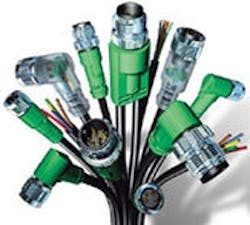Nothing Like Good Connections
A variety of factors come into play when choosing between different types of terminal-block connectors such as standard screw clamps, spring clamps and euro connectors that are used for wire and cable connections in machine control systems.
Tracy Lenz, senior product support engineer for Wago (www.wago.us), says the differences between termination methods boil down to install techniques, long-term connection integrity and maintenance. Screw clamps rely on an installer applying proper torque for termination, but normal operational vibrations and temperature cycling that occur even during machine transport from factory to customer site can loosen screws, notes Lenz. Loose connections eventually will fail if not re-tightened to the appropriate torque spec prior to the component being initially installed, and later during maintenance. “A 20-cent connection can lead to a day’s worth of downtime devoted to troubleshooting,” says Lenz. “Screw clamps typically rely on specialty tools such as torque wrenches or crimpling lugs and installer training to meet appropriate torque specs. Over-torquing essentially crushes the conductor, causing failure.”
[pullquote]But Alan Sappe, product marketing lead specialist for Clipline industrial connection technology at Phoenix Contact (www.phoenixcon.com), says DIN-rail-mounted screw-type terminal blocks are still prevalent in control cabinets, switchgear and specialized signal connections. ”Time-proven screw terminations deliver a secure connection with the highest clamping force, and include mechanisms to help prevent screw backout,” says Sappe. “Another key advantage with screw connection is the ability to land multiple wires to a single terminal, saving panel space.”
To protect against corrosion, some companies, including Phoenix Contact, ensure that the clamping bodies in screw connection terminal blocks are protected by a high-grade, corrosion-resistant galvanic nickel- or tin-plated copper alloy.
As an alternative, says Lenz, spring connections essentially enclose a conductor on all four sides for retention and connection integrity while using proportional clamping forces to ensure a conductor receives clamping forces appropriate to its size. “This eliminates special install tools or special training to ensure screws are tightened to proper torque specs,” says Lenz. “It also prevents damage caused by over-torquing.” Spring clamps also are well-suited to high-vibration applications, since they resist vibration and temperature cycling, while screw connections expand and contract with operating temperature changes, says Lenz.
Compared to screw-type terminations, spring-cage terminal blocks can be a faster method of connection, and can reduce wire termination time by as much as 25% or more, says Sappe.
Alan Stewart, technical and application engineering manager for Weidmüller (www.weidmuller.com), says M12 euro connectors in an IP65/67 housing are usable in harsh environments, where connections must withstand exposure to solvent and chemicals and have the ability to protect from mild impacts.
But, he notes the disadvantages of using M12 euro connectors include a limited number of connections per connector and generally higher prices, although when the price of protecting IP20 connections is considered, the cost of using the M12 connection types is not significantly more. “Often standard connections provide many more ways to make the electrical connections,” says Stewart. “The major differentiator is the environment where the connection is made. Standard connectors generally won’t provide safe and secure connections in harsh environments without some type of protection.”
Jeff Schoenberg, product manager with Turck’s connectivity division (www.turck.com), suggests that lower overall cost and a reduced chance for wiring errors can be an advantage for euro connectors since most terminal-block wiring is done in the field, making it more expensive. Changeover flexibility because of the plug-and-play nature of euro connections is also an advantage when maintenance, repair and operational changes need to be made, since this limits repair costs and downtime of a machine, he says.
Philip Burgert is a freelance writer specializing in the technical trade media.


